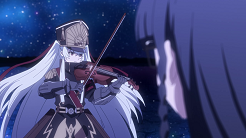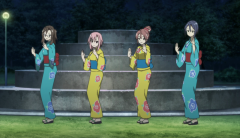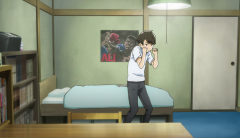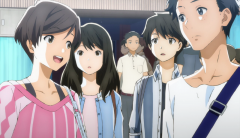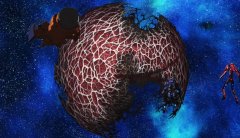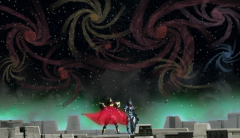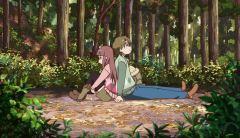(Note: Since psgels didn’t give his final review to the first season, this review is for the entirety of Eccentric Family. If I had to grade the second season alone, it’s 90/100).
Doesn’t matter how you look at it, the Eccentric Family is a unique show, in a way it feels and tastes like no other shows out there, both in and out of itself. Everything surrounding it feel magical just like its world: the series is the only anime show that promoted as a city ambassador (Kyoto Special Goodwill Ambassador), the second season that no one see coming (especially at the time the first season ended the second book hasn’t even written yet), P.A Works studio became the leading unit in production committee of this second season, meaning they are passionate about this series and they have total artistic control over it (as for how influential the anime studios usually have over the decision of their work. Nil. Most of the time they are slave who draw and deliver what were told. Sad fact). This is one of few series where I can see a lot of love was put into those details, from the love of their characters to its rich world settings, to Yasaburou’s various adventures. Of course P.A Works does a magnificent job to visualize that world, but I also credit the success on Tomihiko Morimi’s adept writing. Eccentric Family is at heart a character-driven series, and he’s simply one of the best in this industry when it comes to character writing: eccentric cast of characters who distinctive, whimsical but always insightful and intriguing. I have a lot to say about this world so let get right down to it.
The Eccentric Family’s first and foremost strength comes from its magical-realism Kyoto world where human, tengu and tanuki live together in harmony. I am not at all exaggerating when I say that this setting is my personal favorite anime settings ever. Magical-realism has always been right up my alley: the mundane, ordinary world that mixed in with magical elements that serve as a normality to their world. And sure, in this world a lot of strange things happen: tanuki who transform into human shape and fool around until they get caught and turn into a hot pot tanuki, human who float in the air in broad daylight, a tiger (and bear) appear in the middle of the city. Just by the look of it, this world promises to provide a lot of fun, but this show even goes much more further than that: all the settings that not only gorgeous to look at, they all have strong sense of personality that feel like they get stuck in that specific moments: when you see the rooftop you immediately link to Benten, Yasaburou and the moon; when you see a flying house you would think right back to the Daimonji Festival and the stupid fights between Shimogamo and Ebisugawa’s family.
And to support for both its sense-of-wonder attitude and its magical-realism settings, The Eccentric Family is a masterclass at portraying an impossibly huge interior space that looks much grander than it supposed to be***: the Painting of Hell that literally pull you through hell with Onis doing wrestling and eating ramen; the 3-stories bus that has an upper floor of open air onsen and bamboo pathway; or a shogi board that can suck you into a secret room. Not only that warped sense occurs in space, it happens in time as well. There is a 2-epsiode worth of playtime that dedicated to Yasaburou’s various adventures in a span of a single day, where he enjoyed a public bath, went through hell, watching Oni wrestling, enjoyed mixed onsen, having crazy dinner party and witnessing his uncle got shot. See, those events feel much longer than it supposed to be. This is on purpose, of course, since what is a better way to highlight the enjoyment of busy carefree life by crazy events one after another?
In addition, the Eccentric Family’s greatest strengths come from its characters. The first season contains a great diversity of cast, but that quality really shines through in the second season as the new additions not only fit very well with the old cast, they even outshine them in many moments. Each of them has their own voice, has great arc to develop and their chemistry are natural, warm and insightful. Here comes one of the decision from the P.A Works that I find worth applauding, they never probably introduce a new character to us. Most of the time the new characters just walk in and have a normal conversation with our main casts and we have to work out their name and their role to the story. It helps that nearly every single one of them has their own way of speaking and their own personalities, so it’s not that hard to differentiate one from another, despite a relatively huge cast. It also helps that through we can tell so much about their characters through subtle gestures, so much as the Eccentric Family is one rare show that I can fall for new characters within the first few minutes (I remember you very fondly, Seiran). Our main protagonist, Yasaburou, is an interesting character to follow, throughout the course although all we see about him is having as much fun as possible with no consideration for responsibility, he takes care of everyone arounf him in his own way and in the end, he reaches a personal grown on balancing between those two factors. It’s up in the air if he’s constantly thinking of everything or constantly thinking nothing at all being led by his fool’s blood; but for him anyway, these are the same goddamn thing.
But by all mean, even 95 percent of the time this show treats their characters thoughtfully, the remaining 5 percent whenever the idiotic twins and Soun appear, they unfortunately drag the show down. These characters are the type that we all love to hate, so they possess their annoying traits… all the way, being annoying for the sake of annoying. I have since warmed up to Soun, but the way he came back to life kind of demerit his meaningful death. Another factor that happen in second season, is that sometimes they reprise the events of the first season (the Daimonji festival, the Nise-emon election), and whenever they do that they can’t bring the same impact as the first and seem like they rely on the beaten path.
While the first season focus more about familial bond, the responsibility one would strive to do versus the fun one has to experience through life, the second season follow that freedom sense, but touch on other themes such as self-identity (in term of Nidaime and Benten: one is a tengu who refuse to be one, the latter is a human who wants to become a tengu. None of them are happy), and the fate of love. The romance part is what surprise me the most as I would never expect I would ship for almost all the lovey cute little love here. I also give my hat off to the character designs, as each of the tanuki have human and tanuki counterparts, and we have such huge cast here but nearly every one of them is distinctive and attractive. The animation is thoroughly consistent and the music is really, really well done. In term of production value, I really have no complain.
The Eccentric Family has a lot to recommend on, I would argue that distractors can read the show as un-focus at times, because it feels like they set up for one crazy set-piece after another without a central conflict; but take heed that the majority of its 2-season runtime is about Yasaburou wanders around his city, tries to live the life to the max so it has its merit. I just say this simply; this show is brimming with love in every scene and with shows like this I know why I fall in love anime medium in a first place. The Eccentric Family already has a special place in my heart.
***If you want a real-place equivalent to this, I’d say it’s like the Old Quarter in Hanoi. From the outside you can only see a small pathway between 2 old houses that only wide enough for a bicycle to get in, then you get through that pathway, turn to some small alleys, go up-stair, pass through some small apartments and TADAH: a bookstore, a store and a café located inside all that maze. I was utterly amazed but there’s no chance an outsider would know such a place without the help of the local. And I do worry what going to happen if there is a fire there?




